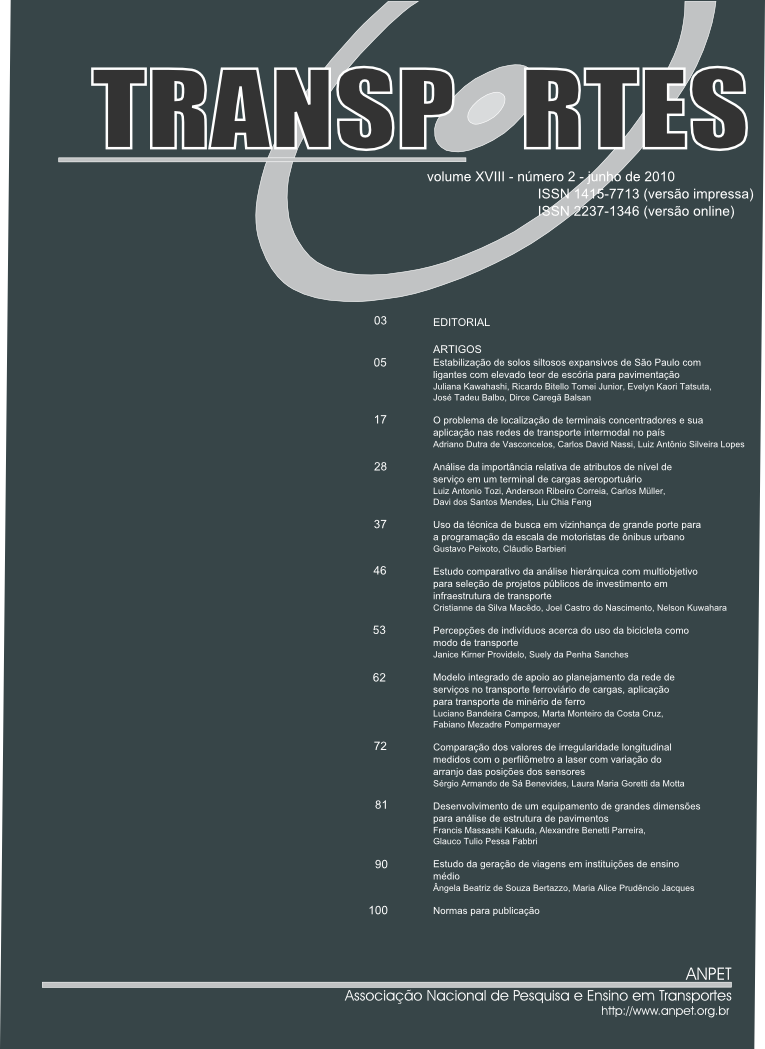Uso da técnica de busca em vizinhança de grande porte para a programação da escala de motoristas de ônibus urbano
DOI:
https://doi.org/10.14295/transportes.v18i2.422Abstract
Resumo: Este artigo apresenta uma nova abordagem para a resolução do Problema de Programação de Tripulações no Sistema de Transporte Público (PPT). O modelo se baseia na metaheurística GRASP cuja busca local é realizada pelo método da Busca em Vizinhança de Grande Porte, conhecida na literatura como Very Large-Scale Neighborhood Search. O grande diferencial da aplicação desta técnica de busca para o PPT é que, além de incorporar os movimentos de realocação e troca de tarefas, realizados tradicionalmente, ela também permite considerar trocas do tipo 3-optimal, 4-optimal, até o limite de n-optimal, para uma solução com n tripulações. A implementação da heurística proposta foi testada com dados de problemas reais de uma empresa que opera em Belo Horizonte, e os resultados foram comparados com as soluções adotadas pela empresa. Desta forma foi possível observar que o modelo apresentado neste trabalho produziu soluções mais econômicas do que aquelas praticadas pela empresa.
Abstract: This paper presents a new approach to solve the Crew Scheduling Problem (CSP) for public mass transport system. The proposed model is based on the GRASP metaheuristic framework, where the local search is performed by the Very Large-Scale Neighborhood (VLSN) search technique. The great differential of this search technique applied to the CSP is that, in addition to task reassigning and swapping movements, adopted in previous work, it also allows considering 3-optimal, 4-optimal, up to n-optimal task movements, for a solution with n crews, yielding to improved solutions. The proposed heuristic was tested with data from real problems of a bus company operating in the city of Belo Horizonte, and the results compared to the manual solution adopted by the company. Thus it was observed that the model presented in this work have produced more economical solutions than those used by the company.Downloads
Downloads
Published
How to Cite
Issue
Section
License
Authors who submit papers for publication by TRANSPORTES agree to the following terms:
- The authors retain the copyright and grant Transportes the right of first publication of the manuscript, without any financial charge, and waive any other remuneration for its publication by ANPET.
- Upon publication by Transportes, the manuscript is automatically licensed under the Creative Commons License CC BY 4.0 license. This license permits the work to be shared with proper attribution to the authors and its original publication in this journal, and to be adapted for non-commercial purposes, provided appropriate credit is given and any derivative works are distributed under the same terms.
- Authors are authorized to enter into additional separate contracts for the non-exclusive distribution of the version of the manuscript published in this journal (e.g., publishing in an institutional repository or as a book chapter), with recognition of the initial publication in this journal, provided that such a contract does not imply an endorsement of the content of the manuscript or the new medium by ANPET.
- Authors are permitted and encouraged to publish and distribute their work online (e.g., in institutional repositories or on their personal websites) after the editorial process is complete. As Transportes provides open access to all published issues, authors are encouraged to use links to the DOI of their article in these cases.
- Authors guarantee that they have obtained the necessary authorization from their employers for the transfer of rights under this agreement, if these employers hold any copyright over the manuscript. Additionally, authors assume all responsibility for any copyright infringements by these employers, releasing ANPET and Transportes from any responsibility in this regard.
- Authors assume full responsibility for the content of the manuscript, including the necessary and appropriate authorizations for the disclosure of collected data and obtained results, releasing ANPET and Transportes from any responsibility in this regard.









